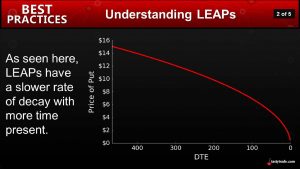Trading LEAPS as a Stock Replacement Strategy
Long-Term Equity Anticipation Securities, often referred to by the nickname "LEAPS,” are options with expiration dates greater than one year from the day of trade initiation.

Options provide investors and traders with the flexibility necessary to express a wider range of market opinions.
Think a stock won’t move for the next several months? Sell a straddle or strangle. Think a stock might get bought out? Buy a call, or sell a put.
But choosing the correct duration for a given trade is also very important—because options have specific expiration dates. Generally speaking, market participants can choose trade durations that might be as short as a week, or as long as two to three years.
For short options trades, previous research conducted by tastytrade suggests that the optimal window is 45 days-to-expiration (DTE). However, that window may not fit every trader’s unique approach or strategy.
But what’s the optimal approach for investors and traders seeking to utilize options trades with a duration of 12 months, or more?
Options with more than 12 months to expiration are typically referred to as Long-Term Equity Anticipation Securities, or LEAPS.
LEAPS are easy to differentiate from other options because their expiration dates typically have the next calendar year (or even the one after that) listed after the month and day. For example, 1/20/23 is the expiration date of LEAPS maturing during the first month of 2023, while 1/19/2024 is the expiration date of LEAPS maturing during the first month of 2024.
Technically speaking, there aren’t any further differences between LEAPS and other standard, exchange-listed options contracts. From a strategic perspective, however, there are of course many important nuances that differentiate LEAPS and shorter duration options.
One of the most important considerations when trading LEAPS is that the future is uncertain. It’s very difficult to predict what the trading environment will look like several months from now, much less what it will look like in a year or two.
In the options world, an increased degree of uncertainty generally translates to higher premiums—which is exactly the case with LEAPS.
For traders of LEAPS, that means there’s the potential for a given option to lose more extrinsic value as the position gets closer to expiration. On the flip side, there’s more time for the position to work.
For buyers and sellers of options, there may be times when a LEAPS position best matches one’s market outlook, based on a longer time horizon.

Stock Replacement Using LEAPS
Like anything in the markets, there’s no set approach or strategy that market participants are required to utilize when trading LEAPS. However, there are several approaches that tend to garner significantly more volume in the marketplace.
For bullish traders, one popular approach is to use LEAPS as a stock replacement strategy. But LEAPS can also be utilized like other options: to generate income using a covered call, to express a bearish outlook, or to hedge a position or portfolio.
When it comes to stock replacement, LEAPS are attractive because of their ultra-long duration. Stock replacement is a bullish approach that calls for the substitution of call options in place of outright shares of long stock.
Generally speaking, the upfront capital requirement for stock replacement is lower than holding long stock, but the holder of such calls is still able to participate in potential gains in the underlying due to the high deltas associated with long-term LEAPS options.
Looking at an example, imagine hypothetical stock XYZ is trading for $15/share. If an investor were to purchase 2,000 shares of XYZ in a cash account, that would tie-up $30,000 in capital (2,000 x $15/share = $30,000).
Now imagine that the 17.5-strike calls which expire in 16 months are trading for $5.00 per contract. In order to control 2,000 shares of stock, that same investor or trader would need to purchase 20 call contracts, because each option contract represents 100 shares (20 x 100 = 2,000).
In order to purchase those 20 call contracts, the investor or trader would therefore need to outlay $10,000 in premium (20 contracts x $5.00 per call x 100 option multiplier = $10,000).
So in each respective position (pure stock vs. LEAPS call options), the investor controls 2,000 shares of stock. However, the stock position starts making money anywhere above $15/share—the price at which the investor purchased the stock.
Alternatively, the option position only starts making money after the underlying stock passes the breakeven point of the call options. In this case, owning the 17.5-strike call for $5 means that the LEAPS investor won’t start making money until the underlying stock passes $22.50 ($17.50 + $5.00 = $22.50). Depending on one’s outlook for XYZ, that type of bullish move might be entirely plausible over the course of the next 16 months.
The best way to examine the potential pros and cons of each respective approach is to look at the profit/loss across a range of scenarios.
Looking at three different scenarios, imagine that in 16 months the following has occurred:
- Scenario 1: XYZ has dropped from $15/share to $5/share
- Scenario 2: XYZ has rallied from $15/share to $22.50/share
- Scenario 3: XYZ has rallied from $15/share to $30/share
The table below highlights the profit/loss for each position (long stock vs. LEAPS calls) according to each of the above scenarios—assuming the stock closes trading at the indicated share price the day before the expiration of the LEAPS.
Long Stock vs. Long LEAPS Calls Scenario Analysis
|
|
Long Stock |
Long LEAPS Calls |
|
Scenario 1 ($5/share) |
($20,000) |
($10,000) |
|
Scenario 2 ($22.50/share) |
$15,000 |
Breakeven |
|
Scenario 3 ($30/share) |
$30,000 |
$15,000 |
This example helps illustrate how a pure long stock position compares with a stock replacement approach using out-of-the money (OTM) LEAPS calls. Investors and traders should note that the approach can also be executed using in-the-money (ITM) or at-the-money (ATM) LEAPS calls.
Using ITM or ATM calls for stock replacement is more capital intensive—due to the increased premium for higher delta calls—but the associated probability of the call finishing in-the-money will also be higher.
Of course, the actual price of the calls in question (whether ITM, ATM, or OTM) likewise plays a big role in the relative attractiveness of replacing long stock with long LEAPS calls.
For example, if the 17.50-strike calls used in the example were priced at $2, instead of $5, that would obviously increase the appeal of the LEAPS options position. As a reminder, metrics such as Implied Volatility Rank (aka IV Rank) can be used to gain additional insight into whether a given option is “cheap” or “expensive” using implied volatility.
Market participants considering a stock replacement approach using LEAPS may also want to consider running a scenario analysis before entering a “live” position. And if one were to use LEAPS for another purpose (i.e. covered calls, etc.) a scenario analysis may also be recommended—much like any other potential position in the portfolio.
To learn more about trading and investing using LEAPS, readers are encouraged to review a new episode of Options Trading Concepts Live on the tastytrade financial network.
For timely insights on everything moving the markets, readers can also tune into TASTYTRADE LIVE—weekdays from 7 a.m. to 4 p.m. CST—at their convenience.
Sage Anderson is a pseudonym. He’s an experienced trader of equity derivatives and has managed volatility-based portfolios as a former prop trading firm employee. He’s not an employee of Luckbox, tastytrade or any affiliated companies. Readers can direct questions about this blog or other trading-related subjects, to support@luckboxmagazine.com.



















